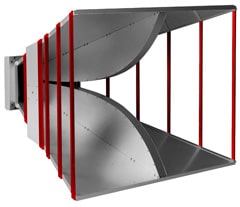The Model 3106B Double-Ridged Waveguide Antenna from ETS-Lindgren is a new, updated version of an industry standard. It has been crafted to generate high electromagnetic fields with relatively low power input and low-level signals where high gain characteristics are needed. The frequency range has been increased from 2 GHz to 2.5 GHz so that measurements can be made over a greater range without stopping for band breaks. Better beam forming has resulted in a single main lobe across frequency so that electromagnetic energy is evenly distributed on target surfaces while improving information for gain and vector measurements. Also, a 6-dB gain improvement has been achieved at 2 GHz, a characteristic that translates into more efficient amplifier use and generation of higher field strengths. At 2 GHz, the 3106B’s gain is 9 dB as opposed to the 3 dB of the earlier 3106 design. The improved performance requires only a calculated 168 watts to generate 200 V/m at one meter as opposed to the 668 watts required by the earlier model. More product information can be found at the ETS-Lindgren website.Whatever your question about antennas—from basic test setups to leading-edge research, it can be posted to the Interference Technology Antenna Forum. Try it now.
Double-Ridged Waveguide Horn Antenna Boasts Extended Frequency Range
